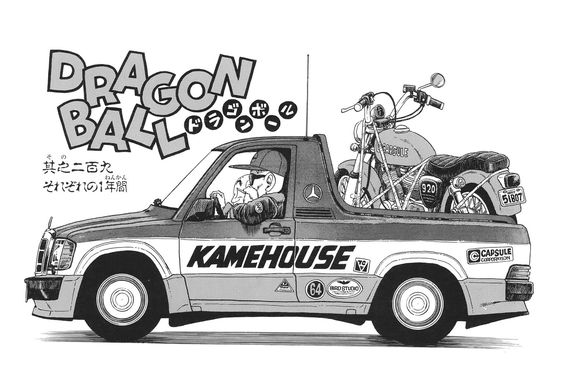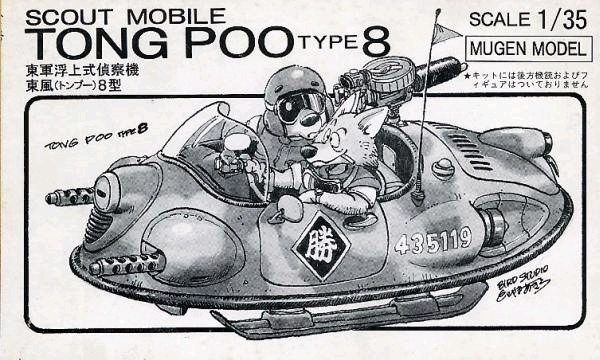This article was written and published back in 2017, so it’s a little out of date. For a more up-to-date look at the same subject, please check out our recent video on Akira Toriyama’s mechanical designs embedded below.
Akira Toriyama, unappreciated? That’s a difficult statement to take at face value, but allow me to explain: Despite worldwide success achieved through his work on Dr. Slump, Dragon Ball, and Dragon Quest, acclaim for Toriyama tends to focus on the shonen storytelling of Dragon Ball or the inventive characters he imbues all of his work with and rarely on his talent as a mechanical designer.

Toriyama’s early work, like Dr. Slump and pre-steroids Dragon Ball, provided him ample opportunity to show off his mechanical design chops and highlight his appreciation for real-world machines. Dr. Slump tankoubon covers often featured the cast paired with real-world hardware (particularly lots of World War II aircraft), a tradition that carried over to the vehicle-heavy chapter title pages of Dragon Ball. The comic’s Capsule Corporation –known for allowing complex machines and structures to be stored in tiny little capsules– also allowed Toriyama ample opportunity to include lots of his own original vehicles, too. The result was an unusual blend of real-world hardware and original sci-fi vehicles existing within the same book; a dichotomy that worked thanks to Toriyama’s talents for rendering real-world machines in his own distinctive deformed style while still retaining detail and authenticity.

The real-world designs Toriyama does incorporate in his work suggests Toriyama is into some properly obscure stuff. Just to name a few that stuck out: an obscure British sports car called the Reliant Scimitar SS1, the Horten Ho 229 “flying wing” prototype aircraft, and a style of Mercedes-based pickups that were being produced by custom shops in the ’80s and ’90s but never officially rolled out of a Mercedes factory. That kind of obscure vehicular knowledge isn’t unusual for artists, but it stands as a contrast to the mainstream appeal of his work – an otaku artist that creates work for everybody.
If you enjoy articles like this, please subscribe to Zimmerit using the form in the sidebar to your left!
Toriyama’s original designs are typified by exaggerated proportions and an “egg” shape, easily recognizable if you’ve ever seen any of Capsule Corp’s products. Those proportions aren’t simply a Capsule Corp thing, though, because looking through the breadth of his work it becomes evident that that’s just Toriyama’s style. He draws everything like that.
Early Adventures in Mechanical Design

Sometimes Toriyama combines real machines with the fantastic, as was the case for his short comic Mr. Ho (1986). Not only did Mr. Ho feature a Ferrari Dino hovercar driven by a couple of anthropomorphic dogs (yet another Toriyama hallmark thankfully outside the purview of this article), but the eponymous hero drives a Porsche 356 Super Speeder hovercar. The 356 Super Speeder –which looks a bit like a svelte Volkswagen Beetle convertible– is far from the most famous Porsche ever built, but it’s known for being the model of car James Dean raced before trading it in for the car that killed him, a Porsche 550 Spyder. Intentional or not, Mr. Ho’s 356 meets a similar fate when a pretty girl walking her giant bird distracts him and he runs it into a tree.

If you’re looking to trace Toriyama’s homegrown “Capsule Corp style” back to a particular work, it might not be a bad idea to look at the series where the company first appeared. No, it wasn’t Dragon Ball.
The Adventures of Tong Poo (1983) was a one-shot comic that appeared in Shonen Jump and, along with another one-shot published the same year called Dragon Boy, served as a bit of a trial run for Dragon Ball. Not only does Tong Poo feature obvious analogues for both Goku and Bulma, but the interplanetary story, aliens, and capsules that turn into houses and aircraft should all feel familiar. Toriyama even reused the name “Tong Poo” years later for a garage kit he designed, but the model connections in Tong Poo don’t end there – the story’s Bulma analogue is named “Plamo.”

An Old Man and a Tank
Like Katsuhiro Otomo, a large part of Toriyama’s early work remains unknown to English-speaking fans. His short comics, particularly those released prior to Dragon Ball, remain unavailable as English-speaking editions, though many have been released in French and Spanish.
One of Toriyama’s short manga that is easily accessible in English is SandLand. Published in 2000, it’s newer than both Mr. Ho or Tong Poo, but it’s one of his most vehicle-centric comics. SandLand is a story about an old war vet and the demon Beezelbub, who team up to search for a source of water in a post-apocalyptic desert. That makes it the closest thing you’ll find to Toriyama’s take on Mad Max: Fury Road – assuming you ignore the fact it was published 15 years prior, of course.
Much of the story in SandLand takes place as the heroes travel in a tank stolen from the army of an evil king. It’s an original Toriyama design but shows obvious real-world influence with a turret that looks like a cross between a Somua S35 and an AMX 40 (both World War II-era French tanks) and the treads of an A15 Crusader (a British tank of similar vintage). The comic’s other vehicles show obvious World War II influences, with transport trucks that look like old Citroens and an offroad car reminiscent of the Kubelwagen.

But, lest we think all these mechanical designs and illustrations come easily to an artist as accomplished as Toriyama, the SandLand trade paperback begins with this somber author’s note:
“This was supposed to be a short, simple manga about an old man and a tank which I made for my own personal enjoyment. But the tank was harder to draw than I expected, and I stubbornly insisted on drawing it all myself, so I came to regret ever getting involved with it. But the story was already plotted out to the end, so I couldn’t change anything, and I went through hell drawing the whole thing.”
Designer for Hire

Outside of his own comics, Toriyama has dabbled in design work for other projects. His most famous design gig is no doubt Dragon Quest, which he’s been working on since the series began back in 1986. Given the fantasy scope of that series, it’s not particularly relevant to what we’re talking about, but it’s worth mentioning his design work on Squaresoft’s Chrono Trigger role-playing game featured a robot character creatively named “Robo” and a hovercraft not dissimilar the designs already discussed in this article.
Much earlier in his career, Toriyama was a designer for the film Crusher Joe (1983). The film employed twelve such guest designers, and alongside other artists on the cusp of huge success like Otomo and Rumiko Takahashi, Toriyama designed a single object that appeared in the lavish film. Dubbed the “MAX310,” Toriyama’s contribution was a spindly space station that appeared in the background during the credits. Unlike Toriyama’s later design work, the MAX310 was much more angular and square, making it difficult to recognize as a Toriyama creation. Part of this may have been a conscious attempt on his part to emulate a style similar to the film’s primary designers, Studio Nue, but in any case, a product of Capsule Corp, MAX310 was not.

A Rough Encapsulation
This is by no means a complete listing of all the cool vehicles Toriyama’s designed or illustrated over the years, and such an undertaking would be nearly impossible, anyway. If anything, it’s a reminder that even within the work of well-known artists, there’s still plenty of forgotten material worth diving into.
It’s unlikely that Toriyama will ever be known for his mechanical designs in the way that, say, he’s known for spiky haired heroes, but we’re in the midst of a Dragon Ball resurgence, so there’s never been a better time to call out his other talents. If nothing else, the Desktop Real McCoy line is doing what no Dragon Ball toyline has done before and has turned many of Toriyama’s more iconic vehicle-based illustrations into detailed figures. More of that, please.
Special thanks to Fraser Darroch with the Crusher Joe angle and to Tom for asking “Hey, has anyone ever written about this before?”
Further Reading
Support us on Patreon!
Contributor articles like this are supported in part by our readers. If you like this kind of content, please consider supporting Zimmerit on Patreon.


